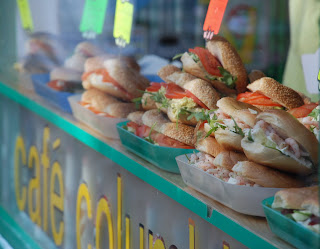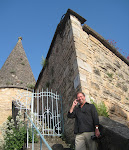Bloomsday is a commemoration observed annually on 16 June in Dublin, Ireland and elsewhere to celebrate the life of Irish writer James Joyce and relive the events in his novel Ulysses, all of which took place on the same day in Dublin in 1904. The name derives from Leopold Bloom, the protagonist of Ulysses, and 16 June was the date of Joyce's first outing with his wife-to-be, Nora Barnacle, when they walked to the Dublin village of Ringsend.
In Mel Brooks' 1968 film The Producers, Gene Wilder's character is called Leo Bloom, an homage to Joyce's character. In an earlier scene in which Bloom first meets Max Bialystock, the office wall calendar shows that the current day is 16 June, indicating that it is Bloomsday.
Tuesday, 16 June 2009
Monday, 15 June 2009
Sunday, 14 June 2009
Saturday, 13 June 2009
Tuesday, 14 October 2008
Petticoat Lane Market


On Sunday, as part of our Photographing East London Markets class we were back out on the streets east of the city of London. Yes, it is a world apart from the leafy Regent’s Park part of town we inhabit. After visiting the Columbia Road Flower Market and another brief return to Brick Lane (in the sunshine this time!) we moved on to our last market. Petticoat Lane Market located on Wentworth and Middlesex Street has been around as an informal market since 1608, and is one of three well known markets east of the City of London (not formally recognized until an Act of Parliament in 1936). A few hundred yards to the north is Old Spitalfields market, and across Commercial Street, to the east, lies Brick Lane Market. A half mile further east is the Columbia Road Flower market.




Huguenots fleeing persecution arrived here in the late 17th century settling mostly in Spitalfields. From the mid-18th century, Petticoat Lane became a centre for manufacturing clothes and The Lane' is renowned for the 'patter' of Cockney rhyming slang and the market traders themselves. The market is open Monday-to-Friday on Wentworth Street alone, but on Sunday extends over many of the surrounding streets, with over 1000 stalls. It closes on Sundays at about 2 pm, and is closed on Saturday.

Petticoat Lane was the least pleasant of the three markets we visited over these past two Sundays. This market really isn’t a tourist attraction. We were warned several times how unsafe the area is! It is not a place I would go back to again. The stall holders really dislike having their picture taken and are quite vocal about it. We met one in the form of a chestnut seller! To be honest I did buy a pashmina but wouldn’t buy any other types of clothing here. Just not me and I was happy to leave.


.
Monday, 13 October 2008
The Columbia Road Flower Market
 The Columbia Road Flower Market is off the Hackney Road in the Tower Hamlets. This is where Jeff and I spent a lovely autumn day on the second day of our Photographing East London Markets class. The weather was warm and sunny so much better than our rainy excursion to Brick Lane last Sunday! The Columbia Road Flower Market was one of the very first car trips we made when we moved to London ten years ago. It gets overwhelming crowded in the summer and we have stopped going preferring to go to the New Convent Garden Market early on a Saturday morning. We did manage a bagel before class though..
The Columbia Road Flower Market is off the Hackney Road in the Tower Hamlets. This is where Jeff and I spent a lovely autumn day on the second day of our Photographing East London Markets class. The weather was warm and sunny so much better than our rainy excursion to Brick Lane last Sunday! The Columbia Road Flower Market was one of the very first car trips we made when we moved to London ten years ago. It gets overwhelming crowded in the summer and we have stopped going preferring to go to the New Convent Garden Market early on a Saturday morning. We did manage a bagel before class though.. 
Much of Columbia road is part of the Jesus Green Hospital Estate. The market is open every Sunday from 8 am to 2 pm. A wide range of wonderful plants, bedding plants, shrubs, bulbs and freshly cut flowers are available. The market also has a number of shops selling bread and cheeses, antiques and garden accessories. Jeff and I own not one but two "Columbia Carriers"; an inexpensive plastic/fabric bag with a large flat base for carrying trays of plants.

The original market was established in 1869 as a covered food market, by Angela Burdett-Coutts with 400 stalls; with flats above, in a tall Gothic building. A planned railway line was never built with traders preferring to sell outdoors anyway causing the market to close in 1886; the original building was demolished in 1958.

The market was moved to Sunday, by Act of Parliament, in order to accommodate the needs of local Jewish traders. This also provided the opportunity for Covent Garden and Spitalfields traders to sell their stock left over from Saturday. The enduring love for cut flowers and plants amongst people in the East End was introduced by Huguenot immigrants. The market suffered in World War II, from rules prioritizing food production, and went into a long decline. A large civilian shelter, beneath the market, suffered a direct hit by a 50 kg bomb, on the night of Saturday, 7 September 1940, at the height of The Blitz.

Wednesday, 8 October 2008
Spoonful o Blues
Subscribe to:
Comments (Atom)




















